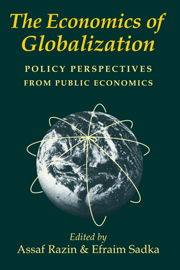Book contents
- Frontmatter
- Contents
- Preface
- List of Contributors
- Introduction
- I International Mobility of Technology
- 1 R&D and Productivity: The International Connection
- II Capital Flows and Exchange-Rate Misalignment
- III Tax Incentives and Patterns of Capital Flows
- IV Limits to Income Redistribution in Federal Systems
- V Tax Harmonization, Tax Coordination, and the “Disappearing Taxpayer”
- VI Political-Economy Aspects of International Tax Competition
- VII Migration of Skilled and Unskilled Labor
- VIII Fiscal Aspects of Monetary Unification
- Index
1 - R&D and Productivity: The International Connection
Published online by Cambridge University Press: 28 January 2010
- Frontmatter
- Contents
- Preface
- List of Contributors
- Introduction
- I International Mobility of Technology
- 1 R&D and Productivity: The International Connection
- II Capital Flows and Exchange-Rate Misalignment
- III Tax Incentives and Patterns of Capital Flows
- IV Limits to Income Redistribution in Federal Systems
- V Tax Harmonization, Tax Coordination, and the “Disappearing Taxpayer”
- VI Political-Economy Aspects of International Tax Competition
- VII Migration of Skilled and Unskilled Labor
- VIII Fiscal Aspects of Monetary Unification
- Index
Summary
… we may say that certainly since the second half of the nineteenth century, the major source of economic growth in the developed countries has been sciencebased technology - in the electrical, internal combustion, electronic, nuclear, and biological fields, among others.
[Kuznets, 1966, p. 10]No matter where these technological and social innovations emerge - and they are largely the product of the developed countries - the economic growth of any given nation depends upon their adoption. … Given this worldwide validity and transmissibility of modern additions to knowledge, the transnational character of this stock of knowledge and the dependence on it of any single nation in the course of its modern economic growth become apparent.
[Kuznets, 1966, p. 287]Introduction
Ninety-six percent of the world's research and development (R&D) is carried out in a handful of industrial countries. The remaining 4% is conducted in a large number of developing countries, though among them only 15 countries perform significant R&D (Coe, Helpman, and Hoffmaister, 1997). This raises the question whether or not the distribution of the benefits of R&D is as skewed as the distribution of expenditures.
Why should we be interested in this question? First, because R&D is an important activity. True, the industrial countries spend only 1.5–3% of gross domestic product (GDP) on R&D, but the rates of return on R&D are so high that even that investment can have a significant impact on output growth.
- Type
- Chapter
- Information
- The Economics of GlobalizationPolicy Perspectives from Public Economics, pp. 17 - 30Publisher: Cambridge University PressPrint publication year: 1999
- 4
- Cited by

